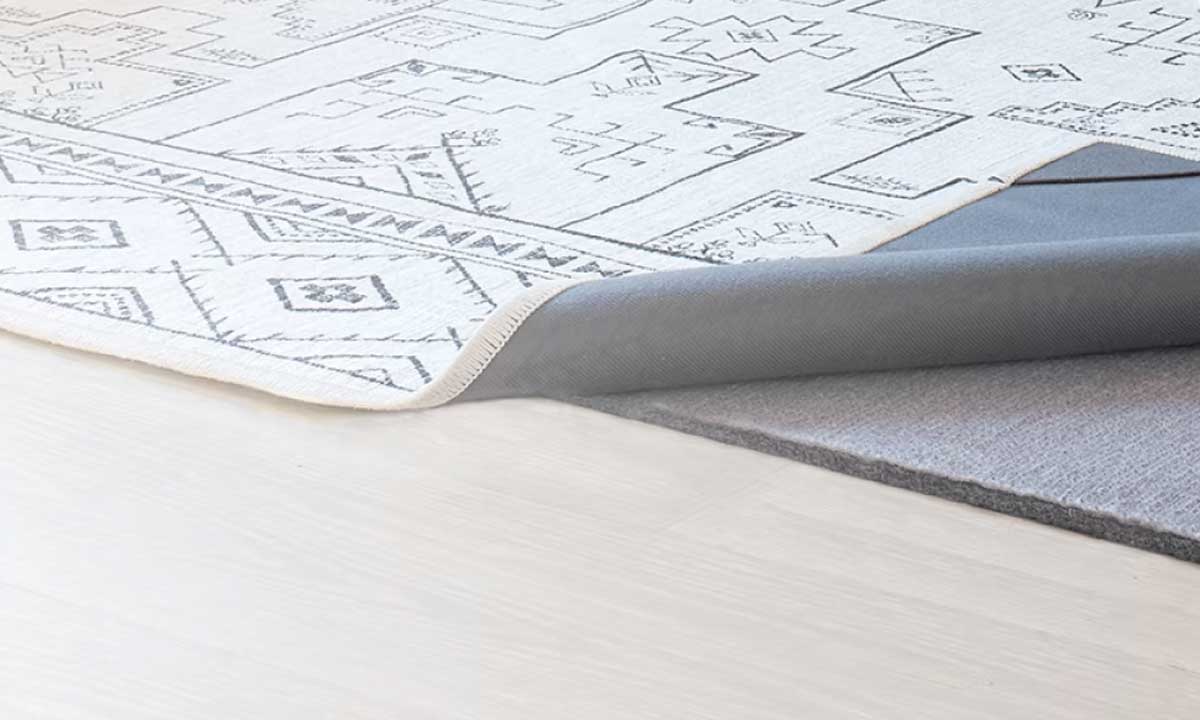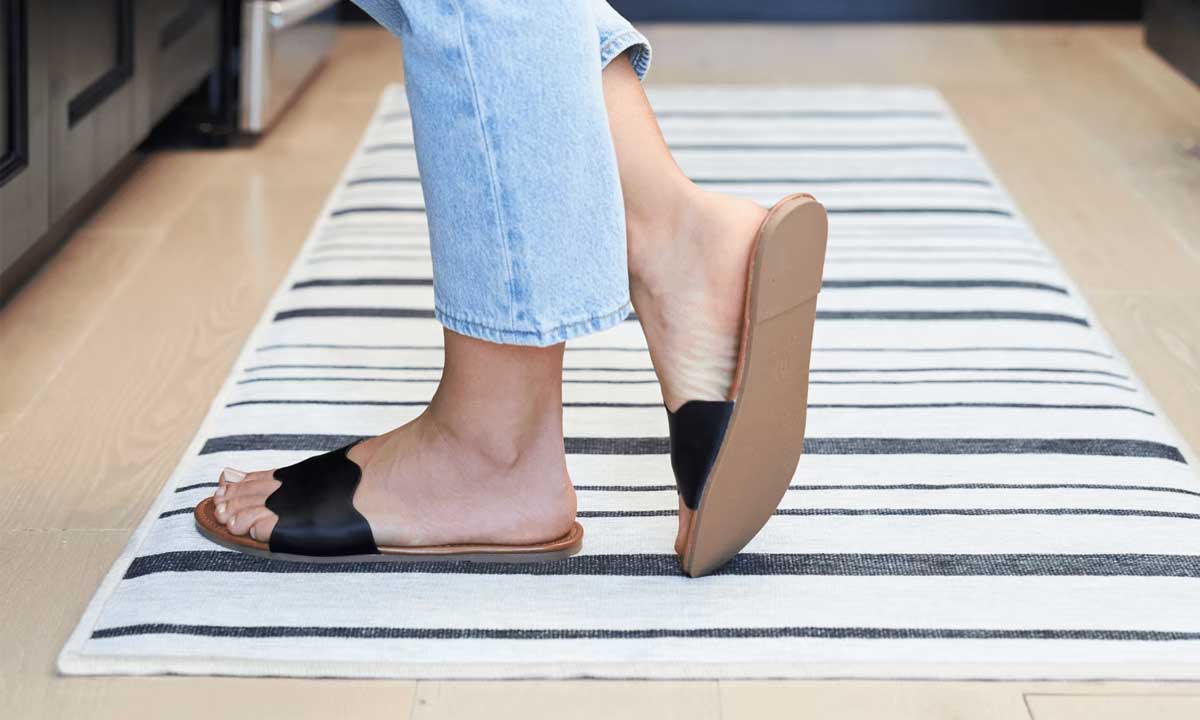Ever wondered why you need a rug pad? Or even what it is?
A rug pad is a handy home essential that keeps your rug secure and helps it last longer. This is a perfect addition to your place because a rug is one of the easiest and quickest ways to add a pop of color, texture, and warmth to any room.
There's much more to discuss. That's why we'll explore the different types of rug pads and show you how to use them to get the most out of your rugs.
TL;DR:
- Rug pads prevent slips and falls, protect floors, and extend the life of your rug.
- They work on both hard flooring and carpeted floors.
- A rug pad should last around 3 to 5 years with proper care.
- Common materials for rug pads include rubber, felt, foam, and combination pads.
- Choose a rug pad based on your flooring type and desired level of cushioning and grip.
What’s the Point of a Rug Pad?
"A rug pad is placed under the rug and serves multiple purposes. It helps your rug stay in place, dampens sound, and (depending on the type of pad) adds extra cushion and support," explains Therese Germain, VP of Core Products at Ruggable.
The main reason to have a rug pad is to prevent slips and falls by keeping your area rug in place. If you've ever stepped on a rug that has moved underfoot, causing it to bunch up, you know how dangerous it can be – a rug pad is a perfect choice to prevent this by creating friction between the rug and the floor, which helps the rug stay in place.
In addition to safety, a rug pad helps your rug lay flat, preventing trip and fall incidents caused by the corners. This is ideal for a new rug rolled up for delivery.
Rug pads also add extra cushion and support. Depending on the type of pad, they can make your rug more comfortable to walk and sit on and even extend its lifespan by absorbing some of the impacts of foot traffic.

The Benefits of Rug Pads
Investing in a rug pad may seem like an additional expense when you already have a rug, but the benefits of using one are well worth it. Not only do they offer safety and comfort benefits, but they can also help extend the life of your rug, prevent slipping, and protect the floors, especially wood floors.

Protect Your Floors
One of the main benefits of using a rug pad is that it helps protect every floor type. The back of a rug can be rough, which can scratch your floor, mostly the hardwood flooring. Even if you're putting your area rug on the carpet, you should still use a good rug pad to protect the carpet underneath. "Rug pads help ensure the longevity of your rug and your floors. The rug pad keeps your rug in place, which helps maintain its shape and prevents it from scratching your floors," says Germain.
Extend the Life of Your Rug
According to Germain, a rug pad helps prevent the crushing of rug fibers, so it stays looking new longer.
A proper rug pad can help extend the life of your rug by absorbing the majority of the impact from foot traffic. Without a pad, the fibers of an area rug can be crushed and show signs of wear much sooner than they would with a rug pad.
Prevent Slipping
Rug pads help to keep rugs in place and prevent slipping, which is especially important in high-traffic areas. At Ruggable, they've built a two-piece rug system, and the Rug Pad is a necessary component of their proprietary system. "Our Rug Pad features a unique cling-effect technology that grips the washable Rug Cover. It offers a non-slip, rubbery bottom that grips Rug Pad to the floor, ensuring our rugs stay in place, even in high-traffic areas," explains Germain.
Related: How a Ruggable Washable Rug Transformed My Apartment
Do Rug Pads Work on Hard Flooring and Carpet?
Many assume a rug pad is only necessary for hard flooring like hardwood or laminate. However, rug pads can also be beneficial when used on carpeted floors.
An area rug adds a lot of friction to your flooring, which can cause damage over time. A rug pad on carpeted floors can help protect your rug and carpets. The rug pad adds an extra layer of cushioning that helps to prevent the rug from rubbing against the carpet fibers, which can lead to premature wear and tear.
In addition to protecting your carpets, a rug pad can also help prevent discoloring and dye transfer stains from your rug. A rug placed directly on a carpet can trap moisture underneath, leading to mold and mildew growth. A rug pad creates a barrier between the rug and the carpet, allowing air to circulate and preventing moisture buildup.
Look for a cushioned rug pad on hardwood floors to provide a soft landing for your feet. Cushioned rug pads add extra comfort and support, making your rug more comfortable to walk and sit on. They also help to absorb impact, which can help extend the life of your rug.
How Long Should You Expect Your Rug Pad to Last?
The answer can vary depending on the type of rug pad you have and how often you use it.
On average, a rug pad lasts from 3 to 5 years. However, some high-quality rug pads can last up to 10 years or more with proper care and maintenance. It's important to note that a well-cared-for rug pad can also help your rug last longer. By absorbing the impact of foot traffic and protecting your floors, a rug pad can help prevent premature wear and tear on your rug.
Some rug pads, like Ruggable's rug pad, are washable to help extend the pad's life. This means you can easily clean it when it becomes dirty or stained. "The Ruggable Rug Cover is light-weight, water-resistant, machine-washable, and easy to spot-clean, making it easier to deal with all kinds of pet- (and non-pet) related accidents too," explains Germain.
In addition to washing your rug pad, inspecting it periodically for signs of wear and tear is essential. If your rug pad starts to deteriorate or lose its grip, it's time to replace it. Using a worn-out rug pad can cause more harm than good, as it may no longer provide adequate protection or prevent slipping.
Read more: The Best Places To Buy Rugs Online
What Type of Rug Pad Should I Use?
When choosing a good rug pad, there are several pad materials to consider, each with its pros and cons. Here is a breakdown of some good materials:
- Rubber: This is a vital part of the rug pad. It keeps the rug from slipping and works fantastically on almost any type of floor, such as tile, wood, and carpet. However, rubber generally offers less cushion than felt pads. There are some eco-friendly choices available, made from natural rubber and plant fibers.
- Felt: These rug pads are made with dense, compressed natural fibers like wool. They protect the floor by providing cushioned padding under the rug. Unfortunately, felt generally doesn’t provide enough grip on its own.
- Foam: Made from materials like PVC and memory foam, a foam rug pad is super lightweight. It is easy to cut and provides good cushioning and grip. However, foam pads are less durable than rubber and may need replacing sooner.
- Combination: This offers the best of both worlds. You can have felt and foam or felt and rubber. Using a combination means you get the cushioning and grip all in one, but it can be more expensive.
How to Use a Rug Pad
Using a rug pad is a simple but important step to protect your floors and extend the life of your rug. Here are some tips for how to use a rug pad effectively:
1. Get the Right Size
When choosing a rug pad, make sure you get the right size. Some rug pads come finished, while others are trimmable. If you opt for a trimmable pad, get one slightly larger than your rug so you can trim it to be the perfect size. You want the pad to be hidden under the rug.
2. Measure and Trim Your Rug Pad
To measure your rug pad, lay it flat on the floor and measure its length and width. Ensure that the rug pad is spread out evenly over the floor surface. Leave a 1-2 inch gap between the end of the rug and the edge of the rug pad. This gap will prevent the pad from peeking out from under the rug.
If you need to trim your rug pad, use sharp scissors or a utility knife to cut it to the correct size. Make sure to trim it evenly on all sides to lay it flat under the rug.
3. Place Your Rug and Rug Pad
To place your rug and rug pad, start by laying the rug pad down on the floor. Then, carefully place the rug on top of the pad. Ensure the rug is centered and straight before adjusting it to its final position.
Cleaning and Maintenance
Once your rug and rug pad are in place, it is essential to clean up any spills or stains immediately. Regularly vacuum the rug to remove dirt and debris that can accumulate over time. This will help prolong the life of your rug and pad and prevent any potential damage to your floors.














